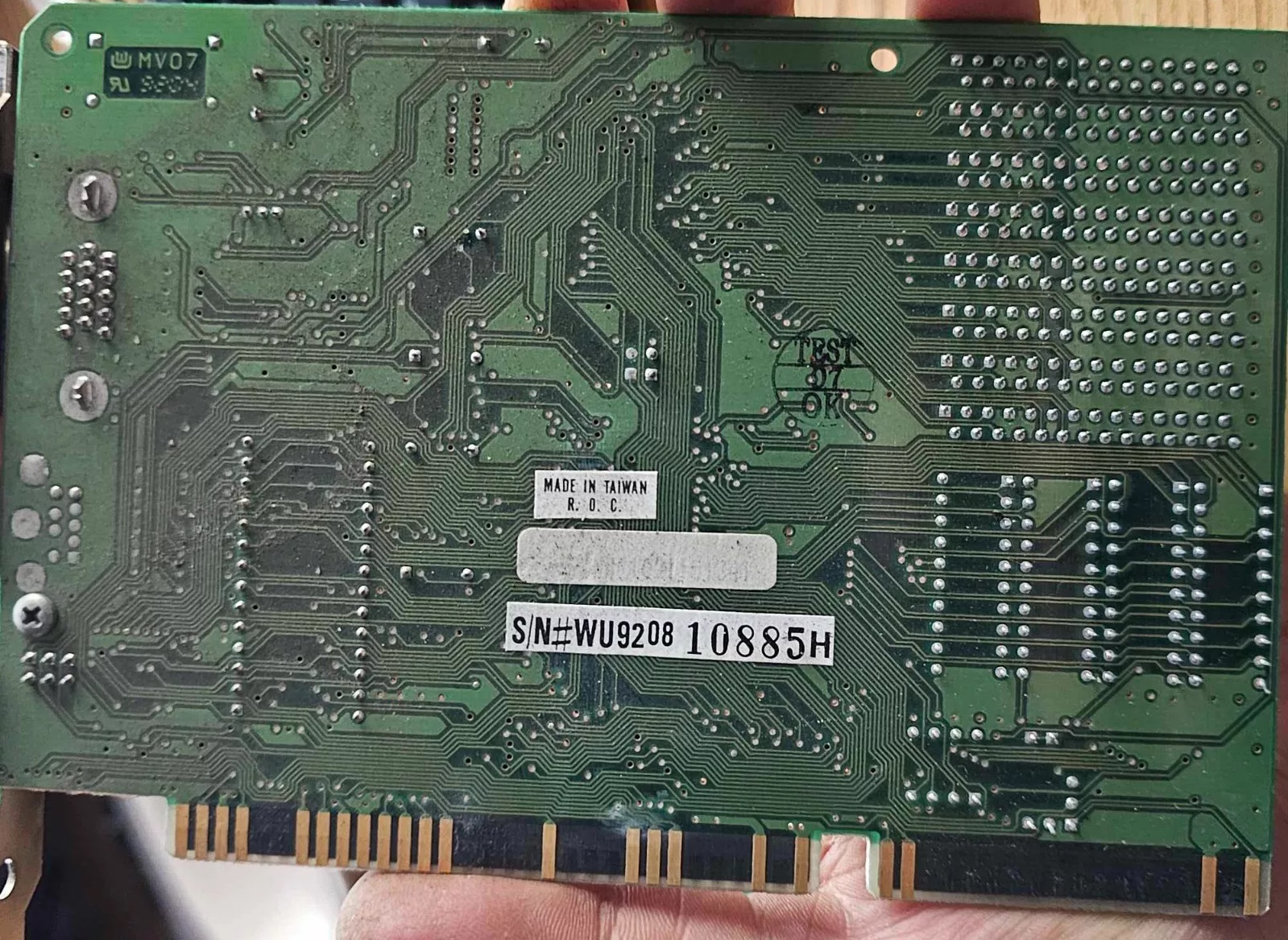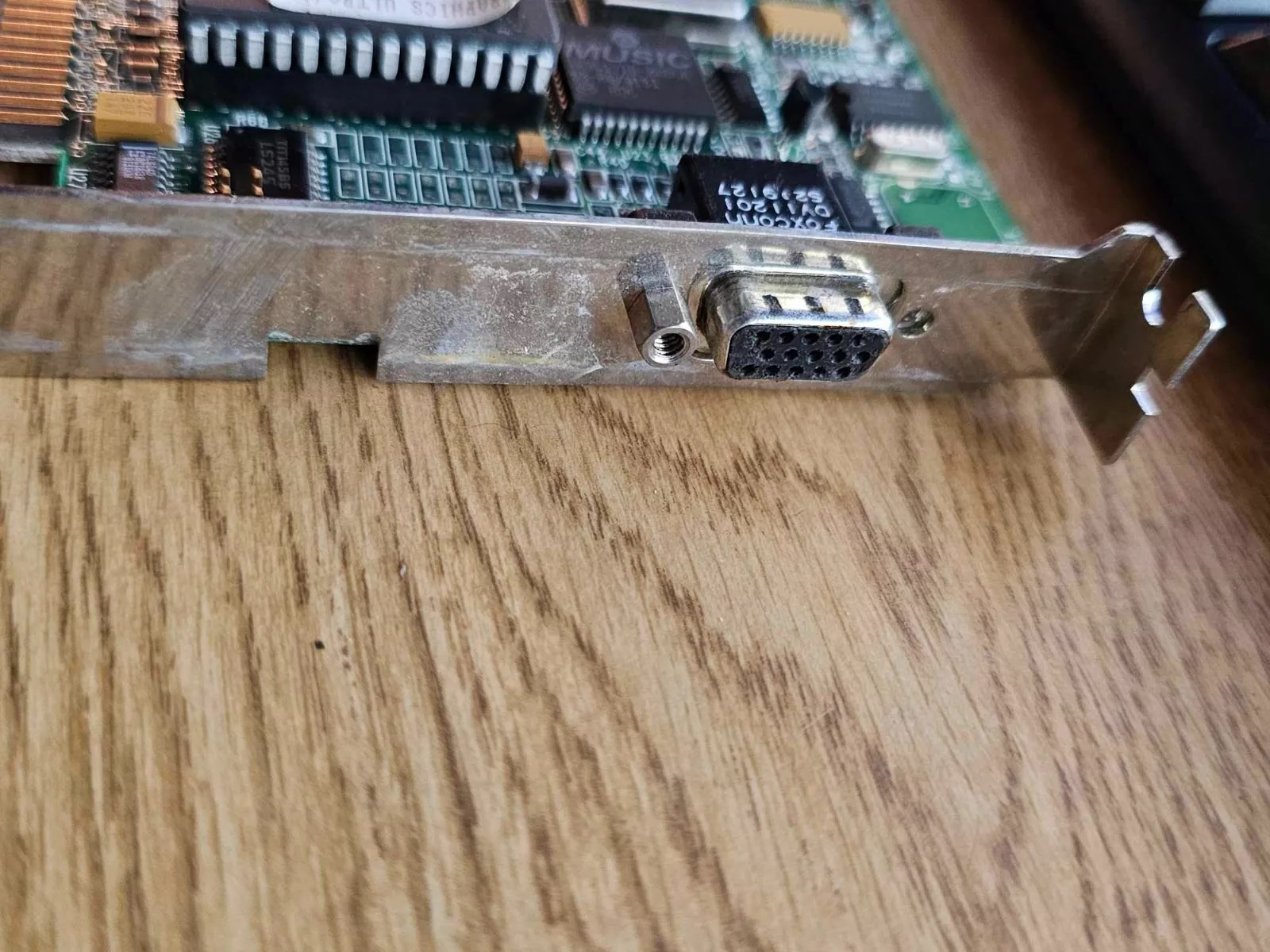ATI Graphics Ultra
The Graphics Ultra was a high-end card from ATi using their first 2D hardware accelerator chip - the Mach8. This was essentially a clone of the IBM 8514/A with a few notable extensions such as "Crystal fonts".
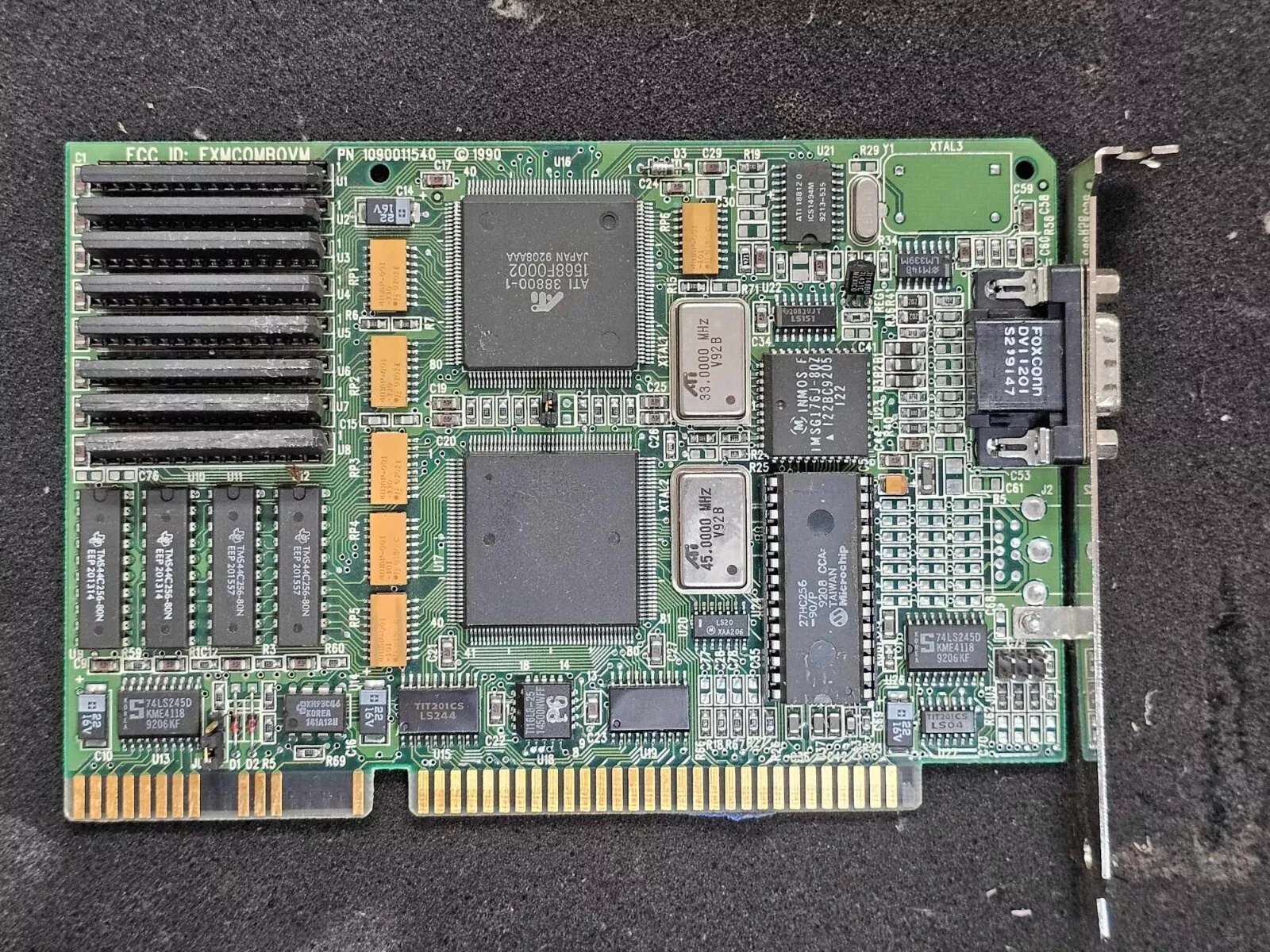 |
Released | Early 1992 |
| Bus | ISA 16-bit | |
| Chipset | ATi Mach8 | |
| Standards | VGA and SVGA | |
| Memory | 512 KB or 1 MB VRAM (32-bit, 80ns) | |
| Ports | 15-pin DSUB (RGB analogue) Bus mouse port |
|
| Part # | 109011540, 109011541, 109011550 | |
| FCC ID | EXMCOMBOVM, EXMCOMBOVM1 | |
| Price | At launch: $699/$899 (512K/1MB), Feb 1992: $419/$479 (1MB/1MB with VGA), Jun 1992: $479 (1MB with VGA) | |
| See Also | Graphics Vantage |
Being one of the first graphics accelerator chips on the market, the Mach8 did not have an integrated VGA core, i.e. it was just an accelerator chip. In order to use the first Mach8 coprocessor, a separate VGA chip was required on the card. A temporary solution was presented with the ATi Graphics Ultra and ATi Graphics Vantage cards, which combined an ATi 8514 Ultra and VGA Wonder+ on a single card (though using discrete ICs). The Ultra was top of the range as it used faster VRAM over the Vantage that used standard DRAM memory.
The Mach8 (ATI38800) was ATI's first true Graphics Accelerator, providing hardware assisted drawing capabilities for 2D primitives like lines, rectangles and polygons. It was register-compatible with the IBM 8514/A Display Adapter. Thus any applications or drivers that supported the 8514/A would run on a Mach8 without any modification. The Mach8 also extended on the 8514/A specification. It did not have any VGA compatibility so a separate VGA controller was required for standard text and VGA modes.
Some Mach8 boards, like the ATi Graphics Ultra and ATi Graphics Vantage included a VGA Wonder+ controller on the same board as the Mach8 to provide this VGA support. The VGA controller had its own memory, completely separate from the Mach8 accelerator's memory. Mach8-based boards were produced in both ISA and IBM Micro Channel versions.
A later version of the Graphics Ultra was released in 1993 called the ATi VGA Wonder GT. This was identical to the 1 MB Graphics Ultra, just rebranded to try to revive sales in the card by leveraging the 'VGA Wonder' name that had been very successful for ATi.
Rough theoretical performance of this card is 10 MPixel/sec pixel rate. Memory performance is 40 MB/s. It blew away its competitors performance-wise upon its release in early 1992.
For more information on the mach8 series of cards, see my dedicated page here.
Board Revisions
The ATI Graphics Ultra came in several board revisions. See my dedicated page here.
Competition
See my dedicated page here.
In the Media
 "At $899 for the 1-MB VRAM version, ATI's Graphics Ultra commands the highest price of the tested accelerators. Based on performance and bundled extras, the Ultra makes a strong case for justifying its price tag.
"At $899 for the 1-MB VRAM version, ATI's Graphics Ultra commands the highest price of the tested accelerators. Based on performance and bundled extras, the Ultra makes a strong case for justifying its price tag. For example, the Ultra leads the field in two of the three performance tests. It ran six times faster than the ProDesigner II in the NotePad and PageMaker comparisons, and it boosted Ami Pro screen scrolls two times faster than the baseline board.
The Ultra teams a proprietary Mach 8 coprocessor, an 8514/A clone, with an on-board VGA controller for compatibility across the range of low and high resolutions up to 1024 by 768 pixels by 256 colors noninterlaced at 72 Hz. A mouse port and Microsoft-compatible mouse come standard with the board.
Unique among the tested products are the scalable screen fonts that ATI bundles with the accelerator. Like Adobe Type Manager and similar products, these fonts, called Crystal Fonts, produce high-resolution letters to make proofing and reading of small text easier. Apparent resolution increases, thanks to the antialiasing algorithm that adds shades of gray to smooth jagged edges of letters. ATI plans to offer a package of 35 additional Crystal Fonts and support for TrueType and Bitstream and Adobe font converters.
As I've already mentioned, the Ultra placed at or near the top in each of the performance tests. In addition, selected menus and repositioned windows appeared instantaneously after my mouse clicks. Less impressive, however, was the screen display. The board provided noticeable improvement in display quality over the ProDesigner II, but compared to other contenders in this review, the Ultra's display was lacking. Icons in Ami Pro were recognizable, but the scissors and other toolbox items looked blurry. Also, the boldfaced main menu text looked muddy, while the Roman fonts identifying applications in the Windows Program Manager were fuzzy."
Byte, January 1992
Performance
I ran some basic DOS performance tests on this card on a much later motherboard running a Pentium III-750 (to avoid other components being a bottleneck for the card's tests). Here's a side-by-side comparison of the results of the ATI VGA Wonder GT (basically an ATI Graphics Ultra), Diamond Stealth VRAM, Tseng Labs ET4000AX card, and a Trident TVGA-8900CL with 70ns DRAMs:
| Diamond Stealth VRAM 80ns (1992) | ATI VGA Wonder GT 100ns VRAM (1993) | Tseng Labs ET4000 1 MB 80ns (1992) | Trident 8900CL 1MB 70ns (1992) | |
|---|---|---|---|---|
| Doom timedemo | 25.6 fps | 34.3 fps | 37.2 fps | 44.5 fps |
| Superscape VGA Benchmark 1.0 | 32.2 | 71.4 | 71.4 | 90.9 |
| Superscape VGA Benchmark 1.0c | 31.9 | 67.7 | 69.3 | 83.6 |
| Chris' 3D Bench | 34.2 (20.5 fps) | 89.0 (53.4 fps) | 92.5 (55.5 fps) | 117.5 (70.5 fps) |
| Chris' 3D Bench SVGA | 7.5 (4.5 fps) | (VESA not found)* | 23.1 (13.9 fps) | 27.9 (16.7 fps)** |
| PC Player 320x200 x 8 bpp | 22.7 | 53.0 | 54.8 | 66.5 |
| PC Player 640x480 x 8 bpp | 3.7** | (VESA not found)* | (VESA not found)* | 15.7 |
| Vidspeed | 65,024 bytes/ms normal RAM 3121 - 3324 (text) 1602 - 1756 (CGA) 1601 - 1757 (EGA) 1592 - 1602 (VGA) 1322 - 1322 (SVGA) |
65,024 bytes/ms normal RAM 3543 - 3555 (text) 2613 - 3527 (CGA) 2608 - 2619 (EGA) 2614 - 3509 (VGA) 1730 - 3593 (SVGA) |
65,024 bytes/ms normal RAM 4561 - 4571 (text) 4545 - 4555 (CGA) 3580 - 3580 (EGA) 3579 - 3605 (VGA) 3579 - 3605 (SVGA) |
65,024 bytes/ms normal RAM 4394 - 4413 (text) 4199 - 4391 (CGA) 4201 - 4320 (EGA) 4082 - 4388 (VGA) 4082 - 4389 (SVGA) |
| Dr.Hard Video Performance | 786,239 cps (direct text 8-bit) 1,550,639 cps (direct text 16-bit) 263,972 cps (write via BIOS) 18,199 cps (write via DOS) 146,247 pixels/s (write via BIOS) 1.55 MB/s text 8-bit 3.09 MB/s text 16-bit 3.15 MB/s text 32-bit 1.57 MB/s graphics 8-bit 1.65 MB/s graphics 16-bit 1.65 MB/s graphics 32-bit 3.1 MB/s max video transfer rate |
920,919 cps (direct text 8-bit) 1,761,759 cps (direct text 16-bit) 358,903 cps (write via BIOS) 18,199 cps (write via DOS) 260,399 pixels/s (write via BIOS) 1.81 MB/s text 8-bit 3.55 MB/s text 16-bit 4.38 MB/s text 32-bit 1.80 MB/s graphics 8-bit 3.51 MB/s graphics 16-bit 4.30 MB/s graphics 32-bit 4.3 MB/s max video transfer rate |
22,578,919 cps (direct text 8-bit) 46,905,039 cps (direct text 16-bit) 438,401 cps (write via BIOS) 25,479 cps (write via DOS) 254,771 pixels/s (write via BIOS) 4.57 MB/s text 8-bit 4.56 MB/s text 16-bit 4.57 MB/s text 32-bit 1.84 MB/s graphics 8-bit 3.58 MB/s graphics 16-bit 4.51 MB/s graphics 32-bit 4.5 MB/s max video transfer rate |
1,146,599 cps (direct text 8-bit) 2,191,279 cps (direct text 16-bit) 352,206 cps (write via BIOS) 21,839 cps (write via DOS) 265,031 pixels/s (write via BIOS) 2.26 MB/s text 8-bit 4.38 MB/s text 16-bit 5.84 MB/s text 32-bit 2.25 MB/s graphics 8-bit 4.40 MB/s graphics 16-bit 5.84 MB/s graphics 32-bit 5.8 MB/s max video transfer rate |
| MonTest v1.93.0B Video Card Performance | 8,387 chars/ms (hard) 900 chars/ms (BIOS) |
10,163 chars/ms (hard) 1,577 chars/ms (BIOS) |
27,261 chars/ms (hard) 1,257 chars/ms (BIOS) |
12,744 chars/ms (hard) 1,046 chars/ms (BIOS) |
*Running UVCONFIG correctly identifies the ATI 38800-1 and sets up UNIVBE for VBE 2.0 and 3.0 extensions, but running these tests still failed.
** This test displayed a corrupted image, with just the top part of the screen being shown and flickering.
The fastest benchmarks are highlighted in bold.
A lot of DOS graphics card performance comes from the speed of the memory - this explains why the Trident card did so well in these tests with its 70ns DRAMs.
This is of course just testing in DOS (I'm not sure how best to benchmark in Windows 3.1), and I have read that VRAM performs worse in DOS and better in Windows. I'm still fairly sure the decision to use 100ns memory on the ATI VGA Wonder GT really hampers what could otherwise be a decent card.
Setting it Up
There is no hardware configuration required for the ATI Graphics Ultra - just run the setup utility on the provided disk to use extended modes. Note that the BIOS on these cards does not support any VESA modes - use the VESA software utility in the Downloads section, UNIVBE, or similar to add VESA modes if required.
Downloads
Windows 95, 98 and NT came with drivers that support the ATI mach chipset - there were none released by ATi.
For OS/2 Warp, choose the IBM 8514/a from 'Selective Install'.
Operation Manual Get in touch if you can provide this missing item! |
Original Utility Disk Get in touch if you can provide this missing item! |
VGA Wonder GT BIOS ROM A dump of my ATI VGA Wonder GT video ROM BIOS (32 KB). |
VGA BIOS ROM Get in touch if you can provide this missing item! |
Mach 8 DOS Tools A cut-down version of the Ultra-8514 utility tools. Allows you to test the card, set the startup video mode, and change the video mode. |
Mach 8 Windows 3.1 Drivers Windows 3.1 drivers for Mach 8 cards. Use the LOADER utility to install. |
Mach 8 Windows 3.1x Drivers ATI mach8 revision 3.0 256 color ATI Desktop driver for Windows 3.1 and 3.11. Runs on Mach8 cards with 1MB of accelerator memory, is faster than previously released drivers with an emphasis on stability. This driver does not support 16 color (4bpp) mode. |
Mach 8 Windows 3.1 Drivers Windows 3.1 drivers for Mach 8 cards. Will work only if you have previously installed an ATI Windows 3.1 driver. If you have not done so, run the installation disk #1 that came with your video card and install the Windows 3.1 driver, before running this driver upgrade install program. |
Mach 8 / Mach 32 Windows 3.1 Drivers Windows 3.1 drivers for Mach 8 cards. Will work only if you have previously
installed an ATI Windows 3.1 driver. If you have not done so, run the
installation disk #1 that came with your video card and install the
Windows 3.1 driver, before running this driver upgrade install program. |
Mach 8 / Mach 32 Windows NT Beta Drivers For the MARCH 1993 Beta Release |
8514 Ultra Install and Config Utilities A stripped-down version of the installation package found on ATI's standard 8514-ULTRA (v4.0) diskettes. Only the following main menu entries will function: |
HDILoad The ATI Turbo AI is a programming interface written exclusively for ATI
mach8 and mach32 accelerator chips. The AI provides access to the graphics
coprocessor by providing a "call interface" to programs performing display |
VESA BIOS Extension For ATI mach8 and mach32 chipset cards. VVESA is not a driver - it is a program (TSR) which enables your video board to be used with VESA-compatible software. |
Driver Module Loader For ATI mach8 and mach32 chipset cards. Works on GRAPHICS ULTRA+ GRAPHICS ULTRA PRO, Graphics ULTRA, Graphics VANTAGE, 8514-ULTRA and other mach8/mach32 products. |
Windows 3.1 Drivers ATI VGA Wonder Series drivers for Windows 3.1. Supports VGA Wonder, VGA Wonder Plus, VGA Wonder XL, VGA Integra, 8514 Ultra, Graphics Vantage and Graphics Ultra. |
More Pictures

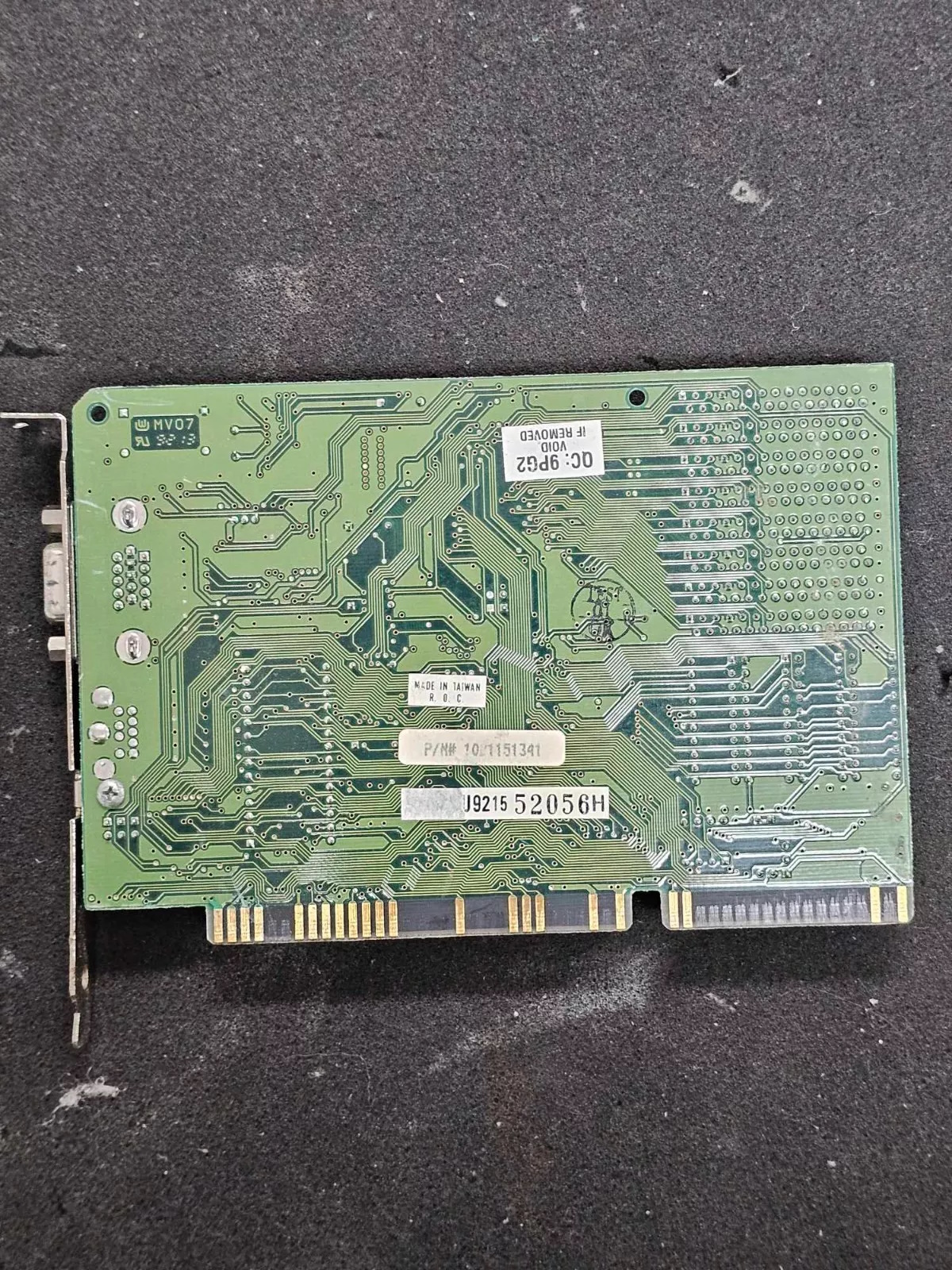
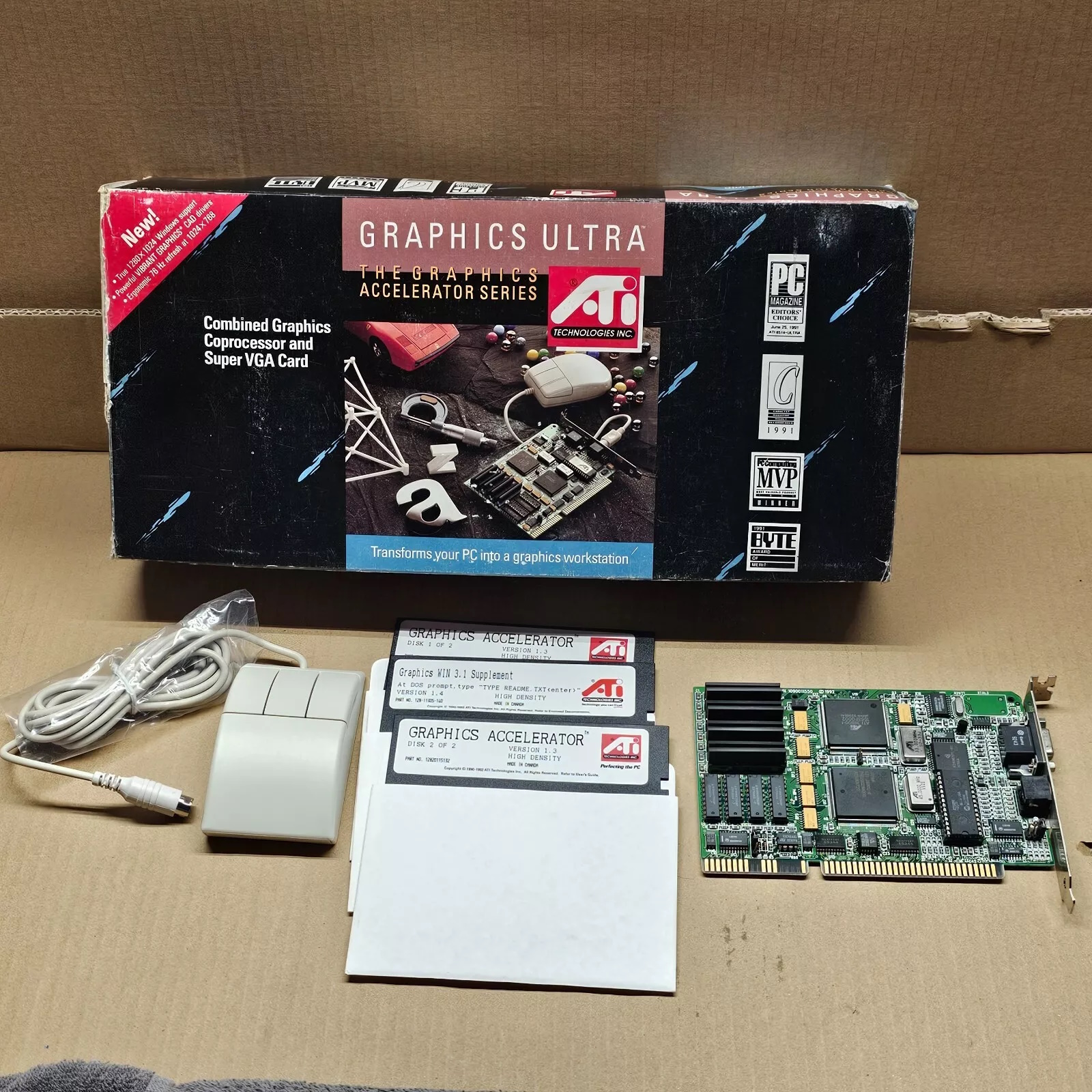
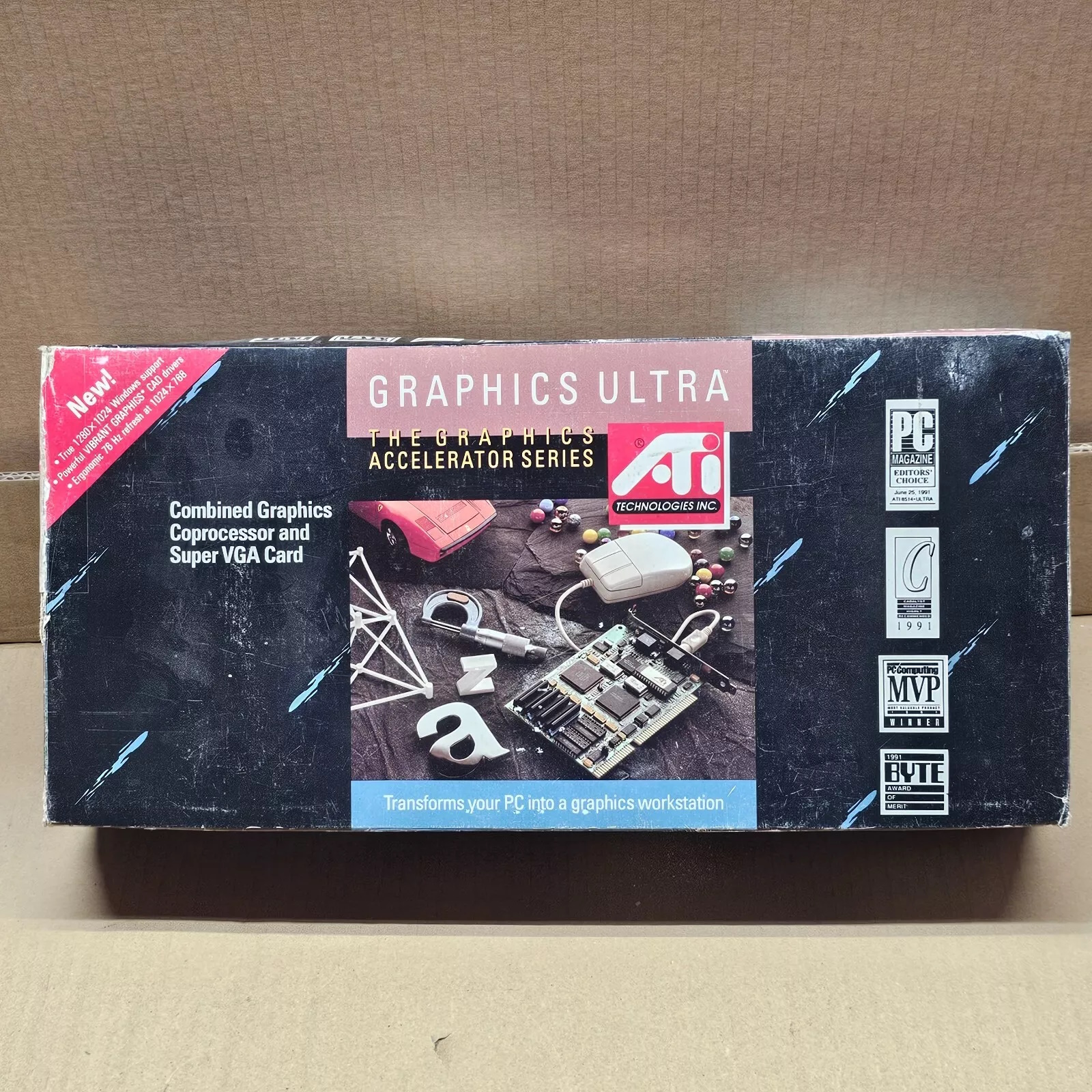
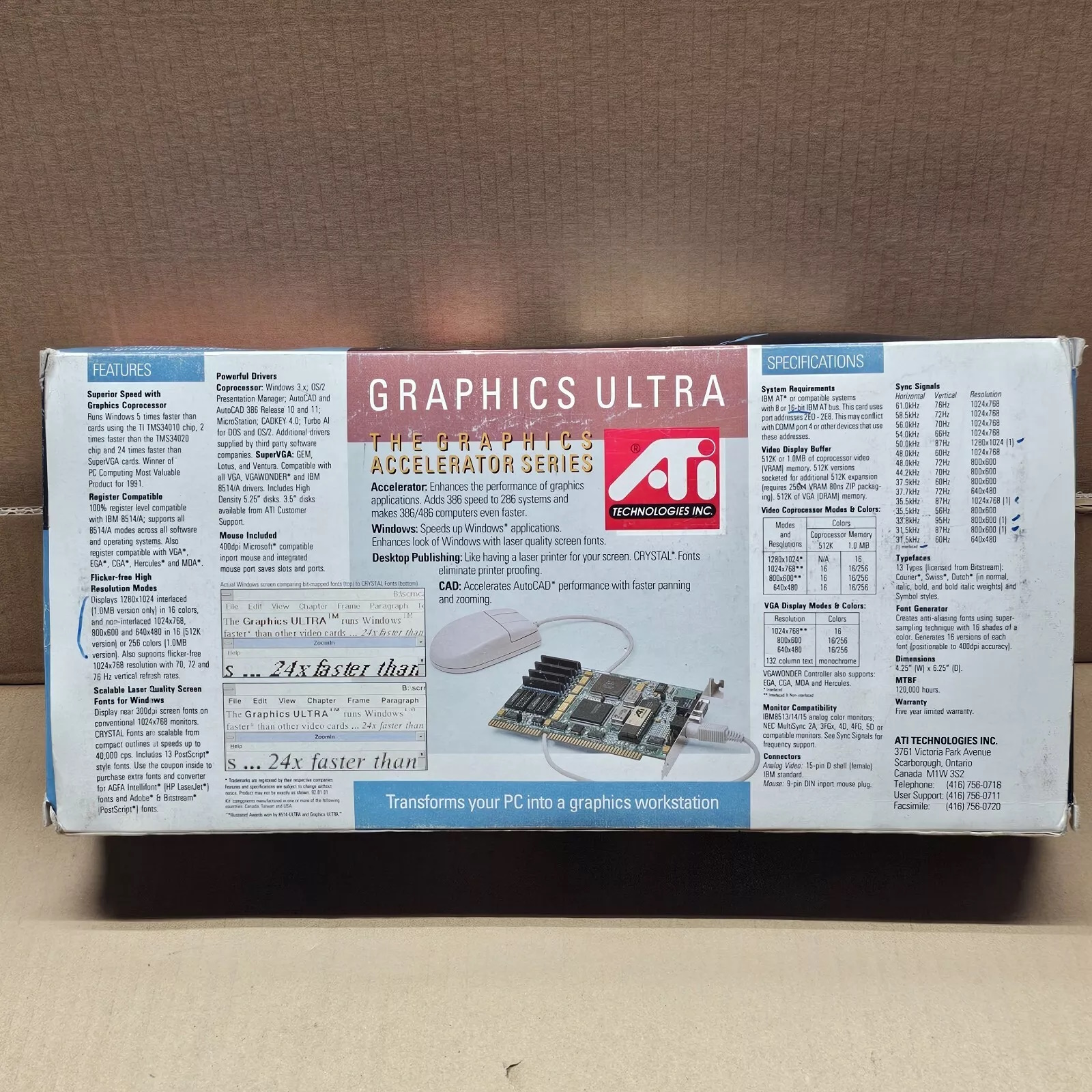
The ATI Graphics Ultra and original retail box
(1992)
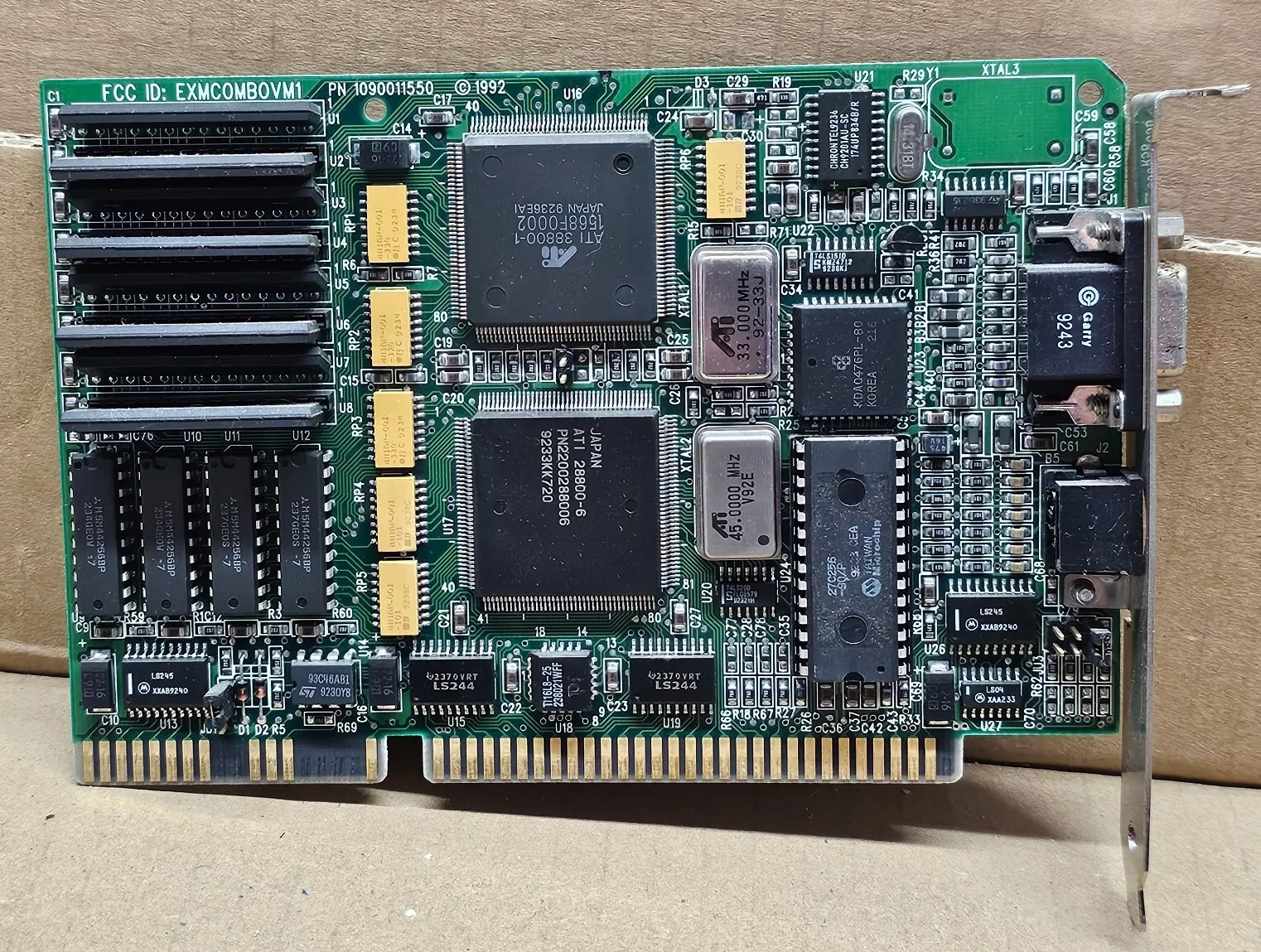
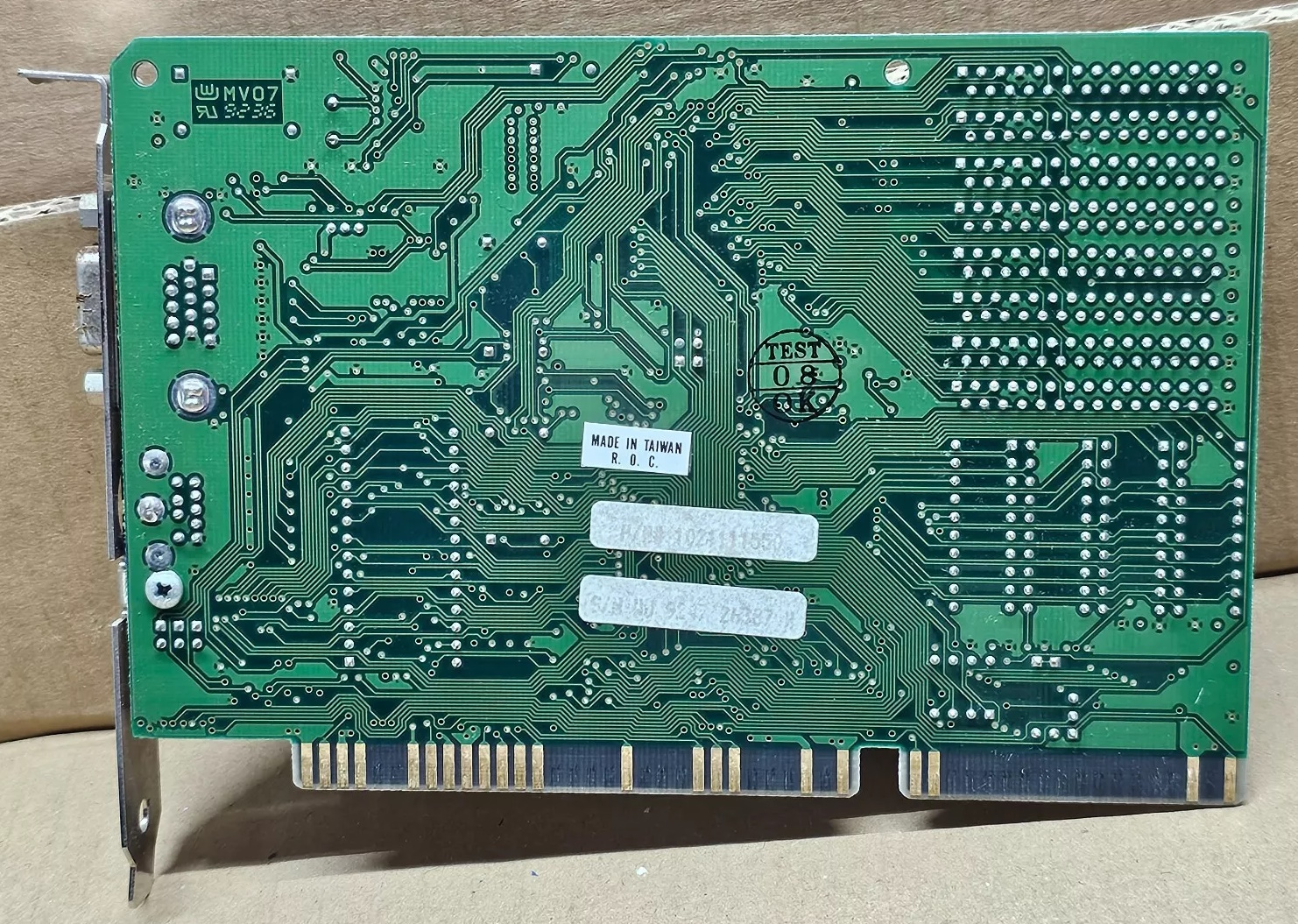
An upgraded ATI Graphics Ultra

